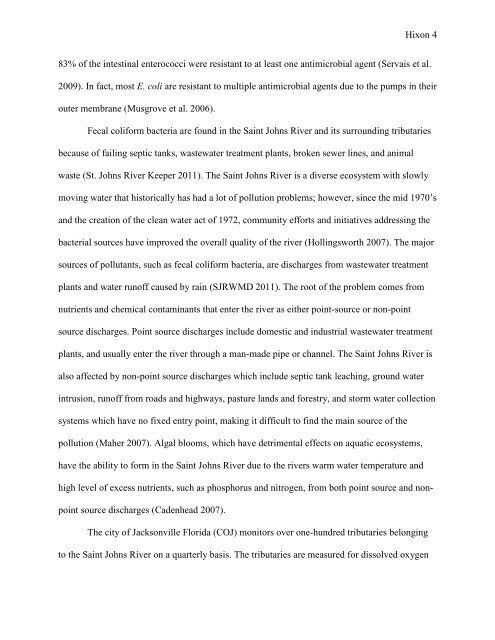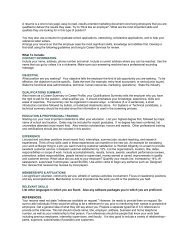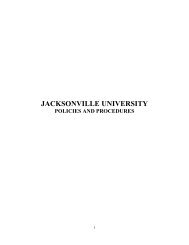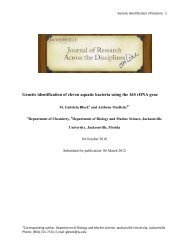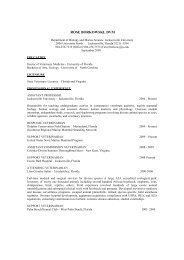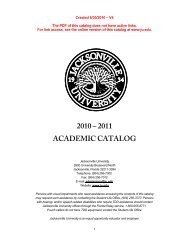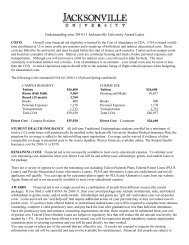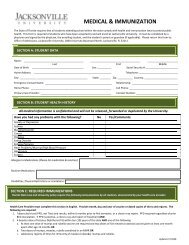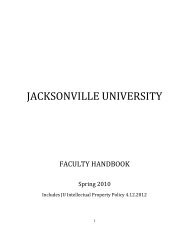Hixon 1 Concentrations and identities of fecal coliform bacteria from ...
Hixon 1 Concentrations and identities of fecal coliform bacteria from ...
Hixon 1 Concentrations and identities of fecal coliform bacteria from ...
Create successful ePaper yourself
Turn your PDF publications into a flip-book with our unique Google optimized e-Paper software.
<strong>Hixon</strong> 4<br />
83% <strong>of</strong> the intestinal enterococci were resistant to at least one antimicrobial agent (Servais et al.<br />
2009). In fact, most E. coli are resistant to multiple antimicrobial agents due to the pumps in their<br />
outer membrane (Musgrove et al. 2006).<br />
Fecal <strong>coliform</strong> <strong>bacteria</strong> are found in the Saint Johns River <strong>and</strong> its surrounding tributaries<br />
because <strong>of</strong> failing septic tanks, wastewater treatment plants, broken sewer lines, <strong>and</strong> animal<br />
waste (St. Johns River Keeper 2011). The Saint Johns River is a diverse ecosystem with slowly<br />
moving water that historically has had a lot <strong>of</strong> pollution problems; however, since the mid 1970’s<br />
<strong>and</strong> the creation <strong>of</strong> the clean water act <strong>of</strong> 1972, community efforts <strong>and</strong> initiatives addressing the<br />
<strong>bacteria</strong>l sources have improved the overall quality <strong>of</strong> the river (Hollingsworth 2007). The major<br />
sources <strong>of</strong> pollutants, such as <strong>fecal</strong> <strong>coliform</strong> <strong>bacteria</strong>, are discharges <strong>from</strong> wastewater treatment<br />
plants <strong>and</strong> water run<strong>of</strong>f caused by rain (SJRWMD 2011). The root <strong>of</strong> the problem comes <strong>from</strong><br />
nutrients <strong>and</strong> chemical contaminants that enter the river as either point-source or non-point<br />
source discharges. Point source discharges include domestic <strong>and</strong> industrial wastewater treatment<br />
plants, <strong>and</strong> usually enter the river through a man-made pipe or channel. The Saint Johns River is<br />
also affected by non-point source discharges which include septic tank leaching, ground water<br />
intrusion, run<strong>of</strong>f <strong>from</strong> roads <strong>and</strong> highways, pasture l<strong>and</strong>s <strong>and</strong> forestry, <strong>and</strong> storm water collection<br />
systems which have no fixed entry point, making it difficult to find the main source <strong>of</strong> the<br />
pollution (Maher 2007). Algal blooms, which have detrimental effects on aquatic ecosystems,<br />
have the ability to form in the Saint Johns River due to the rivers warm water temperature <strong>and</strong><br />
high level <strong>of</strong> excess nutrients, such as phosphorus <strong>and</strong> nitrogen, <strong>from</strong> both point source <strong>and</strong> nonpoint<br />
source discharges (Cadenhead 2007).<br />
The city <strong>of</strong> Jacksonville Florida (COJ) monitors over one-hundred tributaries belonging<br />
to the Saint Johns River on a quarterly basis. The tributaries are measured for dissolved oxygen


